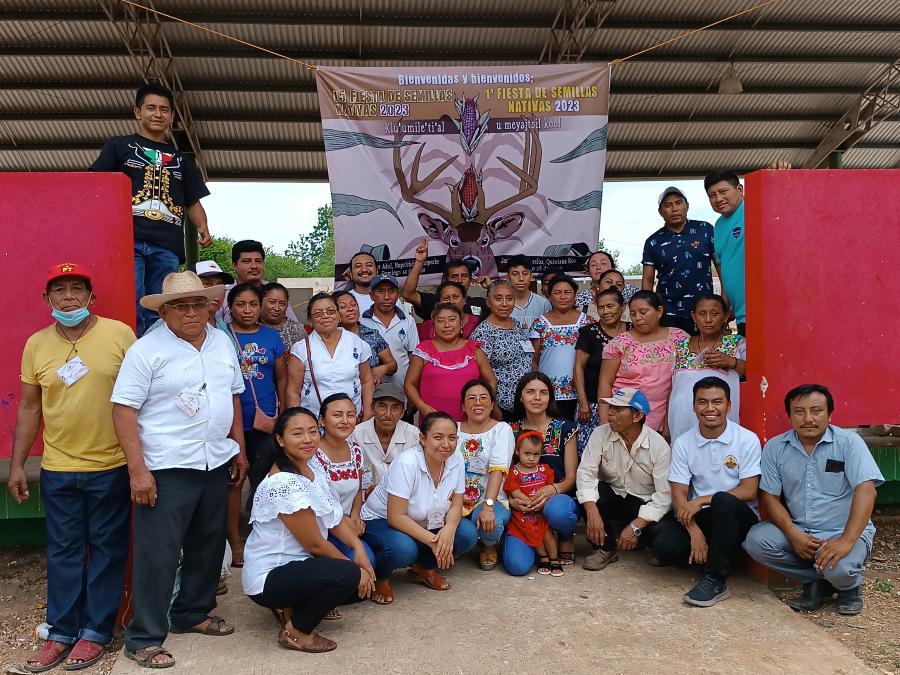Seeing José Benítez Sánchez’s artworks in person is a dramatic experience. His art is intensely colorful and packed with forms and motion. Every square inch is filled, and figures and shapes crowd each other, all formed of yarn pressed onto a beeswax-covered panel. Your eye hardly knows where to land as it tracks the motion and flow of the various elements, and yet for all the artwork’s exuberance there is no chaos here. Every element is calculated and balanced with a sure hand and a master’s eye. This art can sit comfortably next to a Joan Miro painting—or any other modern master for that matter. But there is more to Benítez’s artwork than the art itself. There is a power here that cannot be explained by materials or composition or any other conventional component of painting. And that is exactly the point of his work.
Benítez was a Huichol man (he died in 2009) who transformed his people’s traditional yarn painting into a world-class art form and used it to capture, communicate, and preserve the Huichol’s unique and highly sophisticated cosmology and culture. When Mexico was colonized, the Huichol, who live in the mountains of the northwestern part of the country, largely avoided assimilation because of the inaccessibility of their terrain. More than most other Mexican Indigenous Peoples, they have continued to keep their culture undiluted as much as possible, and do not allow outsiders to enter their territory without special permission.
Their spiritual life is exceptionally complex, involving multiple deities and ancestor spirits, and a crowded round of annual ceremonies and rituals, fasting and sacrifices. There are also long pilgrimages to far-flung sacred sites and the use of peyote to assist in spiritual connections. Their worldview includes not only the present visible world, but also an underworld and an overworld. In fact, much of Huichol life is occupied by observing their spiritual practices, and that is what is reflected in Benítez’s artwork.
Benítez was born in Nayarit in 1938 and was chosen at a young age to be a shaman. At the age of nine he took the first critical step in that process, catching a deer in a snare and breathing in the deer’s last breath before it died. He then had to go into mourning for the sacrificial deer for six years, during which he could not use salt on his food or touch a woman. He continued much of the shamanic training, doing the requisite pilgrimages and ceremonies, but before he finished, he ran away from his community and took up life in larger Mexican society. It was during this period, in the 1960s, that he starting exploring traditional Huichol art, including yarn painting, in which beeswax is spread on a board and colored yarn in pressed into the beeswax to form patterns. It was originally used for votive art only, but it eventually became used for secular art. It was this form where Benítez clearly excelled, taking it to a much higher level of artistic expression.
By the early 1970s Benítez had passed all the other Huichol artists, and others were emulating his style. Those early Benítez artworks are spare and spacious compared to his later yarn painting, but his extraordinary sense of color, form, balance, and composition are clear to see. Still, his work and the Huichol culture were not well known outside Mexico. That’s when he met Juan Negrin, a young Mexican man whose father was the Spanish president ousted by Franco. Negrin had some art training and was immediately struck by both the strength of Benítez’s art and the obscurity of it in the larger art world.
Benítez himself wanted to develop his art further and, particularly, to share Huichol culture and spirituality with the rest of the world, so he and Negrin began a partnership that would last 40 years. Negrin convinced Benítez to resume and finish his shamanic training, and he joined Benítez in the various pilgrimages and ceremonies. This participation was as much Benítez’s idea as Negrin’s. Benítez felt very strongly that the spiritual significance of his artwork should be made clear to non-Indigenous viewers, and he wanted Negrin to act as his representative. For each painting he spent hours explaining the meaning of each element to Negrin, who recorded the conversations and prepared notes to accompany the paintings. “Our memory will stay in these paintings,” he said.
As the years went by, Benítez’s artwork became more and more complex, both visually and thematically, reflecting the peyote-aided visions, dreams, and ceremonial insights he gained from multiple pilgrimages. His renown also grew. His painting The Transcendental Vision of Tatutsí Xuweri Timaiwe’eme (Our Great-Grandfather Who Was Self-Created and Found Knowing Everything) toured the world, and he had a major exhibition at the Museum of Modern Art in Mexico City. His largest yarn painting was commissioned by the Mexican government to be displayed in a subway station in Guadalajara. He won numerous awards and citations along the way, including a national Science and Arts prize. His example also inspired other Huichol artists, who expanded their own approach, raising the form from folk art to high art.
In addition to resuming his shamanic studies, Benítez returned to his traditional community to live, and took up the duties and ceremonial life of a farmer. In the later part of his life he also became a vocal advocate for Huichol living in the slums of the state’s capital city. The most eloquent possible spokesperson for Huichol culture, however, is Benítez’s artwork itself. On the following pages, we offer several of his works, together with an explanation of some of the paintings’ meanings.
Mark Cherrington is the Director of Communications at Cultural Survival



